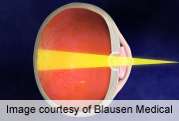Review identifies risk factors for comitant strabismus

(HealthDay)—Risk factors for strabismus include low birth weight, prematurity, retinopathy of prematurity, smoking during pregnancy, anisometropia, hyperopia, and genetic factors, according to a review published online July 11 in JAMA Ophthalmology.
Gail D.E. Maconachie, B.Med.Sci., from the University of Leicester in the United Kingdom, and colleagues conducted a systematic review to identify known environmental and genetic risk factors of comitant strabismus. Forty-one articles were included, which highlighted risk factor, twin, pedigree, and genetic studies.
The researchers identified significant risk factors for strabismus, including low birth weight, cicatricial retinopathy of prematurity, prematurity, smoking during pregnancy, anisometropia, hyperopia, and inheritance. Twin and pedigree studies further supported inheritance, and a complex pattern was revealed. Although various gene loci have been reported, only the STBMS1 locus has been supported.
"Certain subgroups within the population are at higher risk of developing comitant strabismus and should be identified and monitored to allow for earlier detection," the authors write. "It is evident that a strong hereditary link is present particularly in intermittent and accommodative forms; however, further research is required to identify possible links between subtypes of strabismus."
More information:
Abstract
Full Text (subscription or payment may be required)
Health News Copyright © 2013 HealthDay. All rights reserved.

















